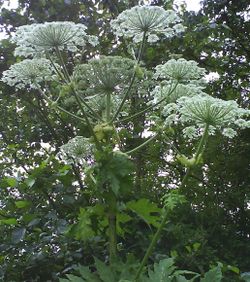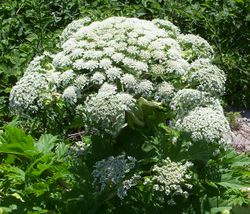Giant hogweed
| Giant hogweed |
|---|

|
| Scientific Classification |
|
| Scientific Name |
|
Heracleum mantegazzianum |
| Image Description |
The giant hogweed is a massive herbaceous plant. Known for its size, the plant can grow from 10 to 15 feet tall [2]. It has hollow stems which are 2-4 inches in diameter [3]. The stalks and stems produce stiff bristle-like hairs, the stems also have spots [2]. These spots are dark reddish-purple and raised. Hogweed plants have compound [3], lobed leaves [2] which can group up to 5 feet in width [3]. These dark green leaves [4] are ternate or ternate-pinnate [5] and coarsely toothed [4]. At the base of the leaf stalk there are white coarse hairs [3]. An individual cluster can grow to 2.5 feet in diameter [6]. The plant also produces a toxic sap which is harmful to humans [3].
Ecology
Giant Hogweed is native to the Caucasus Mountains and southwest Asia. It was introduced in 1917 to the U.S., Europe, Canada, and the U.K. for ornamental purposes [7]. In the U.S. it was brought to Washington, Oregon, Illinois, New York, Pennsylvania, Vermont, Massachusetts, and Connecticut [5]. Giant hogweed prefers moist [3], rich soil and semi-shade [5] but thrives in full sun as well [3]. It can survive with flooding [4]. Capable of rapid colonization this plant typically found growing in backyards, ravines, streams, woods or forests, roadsides [3], vacant lots, and rivers [6]. It is a highly competitive invasive species that crowds out native plant and can co-exist with other aggressive invasive species [4] by forming dense canopies. Hogweed is also known to increase soil erosion [6].
Other
Giant Hogweed is most commonly known for its massive size but also its toxic sap. It's sap is clear and watery and contains toxins which can cause photodermatitis [3]. If the sap comes into contact with skin and is then exposed to sunlight and moisture [8], skin irritaion [8], painful burns, blisters, purple or blackened scars [8], or permanent scarring can occur [8]. And in some cases can even result in blindness [8]. Contact with the sap can occur when one brushes against the bristles on the stem or breaks the stems or leaves [8].
References
- ↑ HeracleummantegazzianumSommier&Leviergianthogweed USDA Plants Agriculture. Web. Last Accessed May 18 2016. Author Unknown.
- ↑ 2.0 2.1 2.2 GiantHogweedorCowParsnip Strathcona County. Web. Last edited August 4, 2015. Author Unknown.
- ↑ 3.0 3.1 3.2 3.3 3.4 3.5 3.6 3.7 3.8 GiantHogweed King County. Web. Last edited February 29, 2016. Author Unknown.
- ↑ 4.0 4.1 4.2 4.3 Giant Hogweed Invasive Species Council of British Columbia. Web. Last Accessed May 15, 2016. Author Unknown.
- ↑ 5.0 5.1 5.2 Giant Hogweed Comparison Table Invasive Plant Atlas of New England. Web. Last edited 11 February 2016. Author Unknown.
- ↑ 6.0 6.1 6.2 giant hogweed Washington State Noxious Weed Control Board. Web. Last Accessed May 15, 2016. Author Unknown.
- ↑ GiantHogweed USDA National Agricultural Library. Web. Last edited May 11, 2016. Author unknown.

